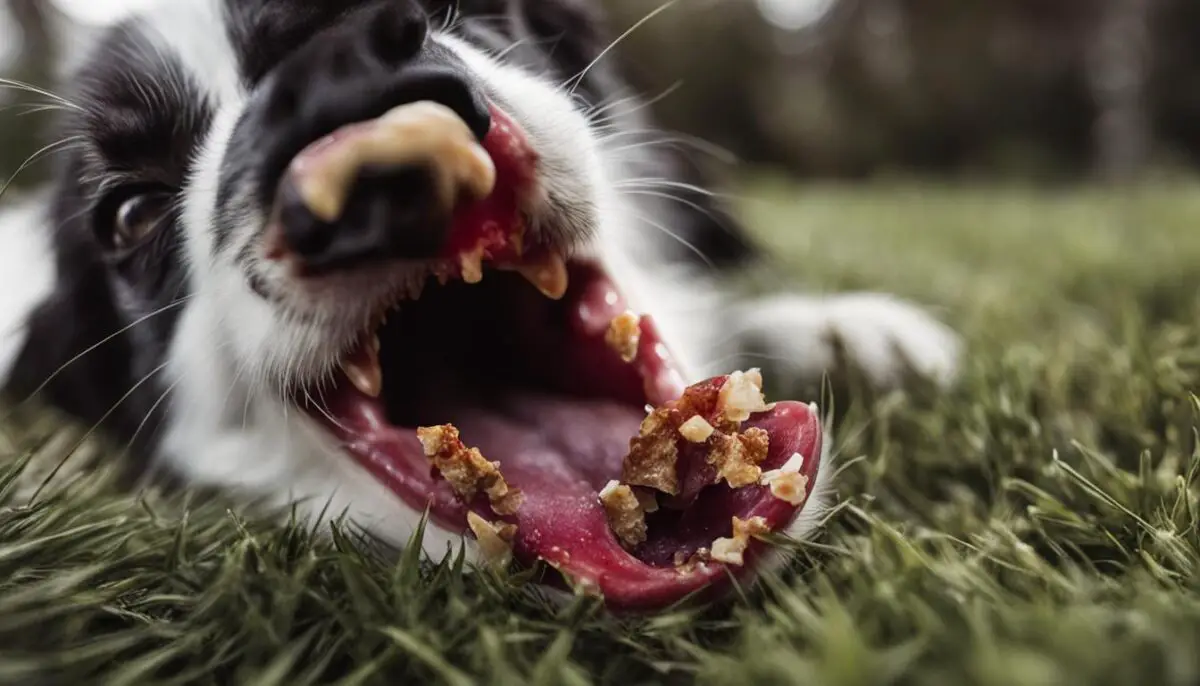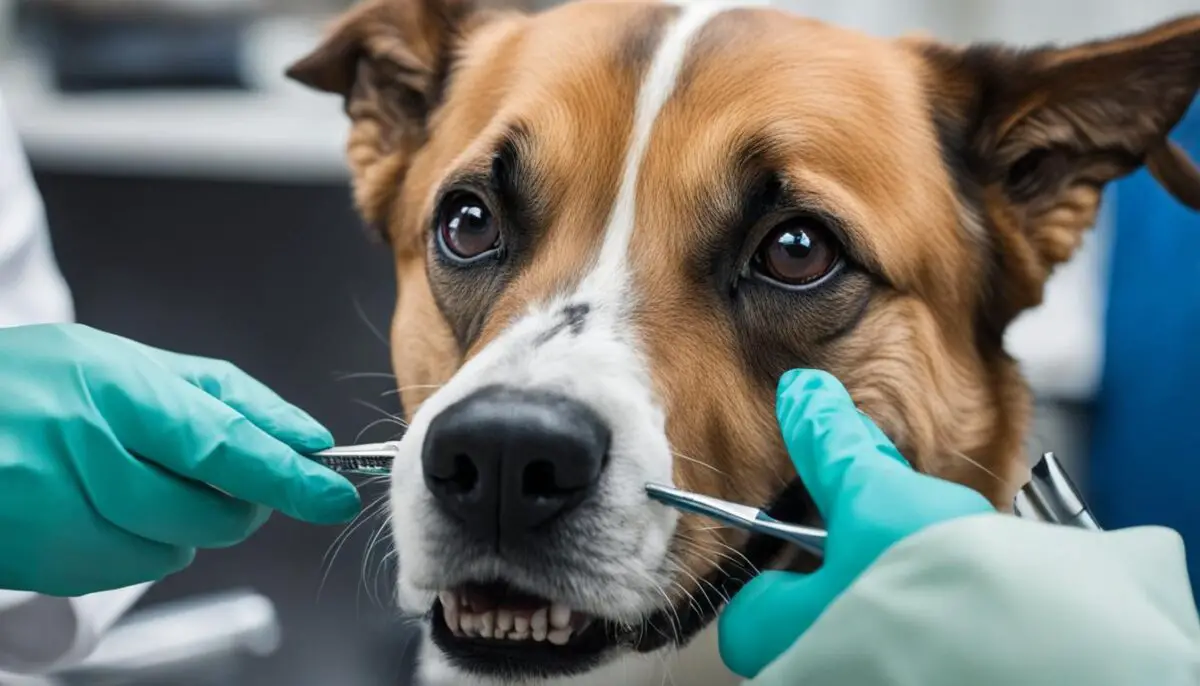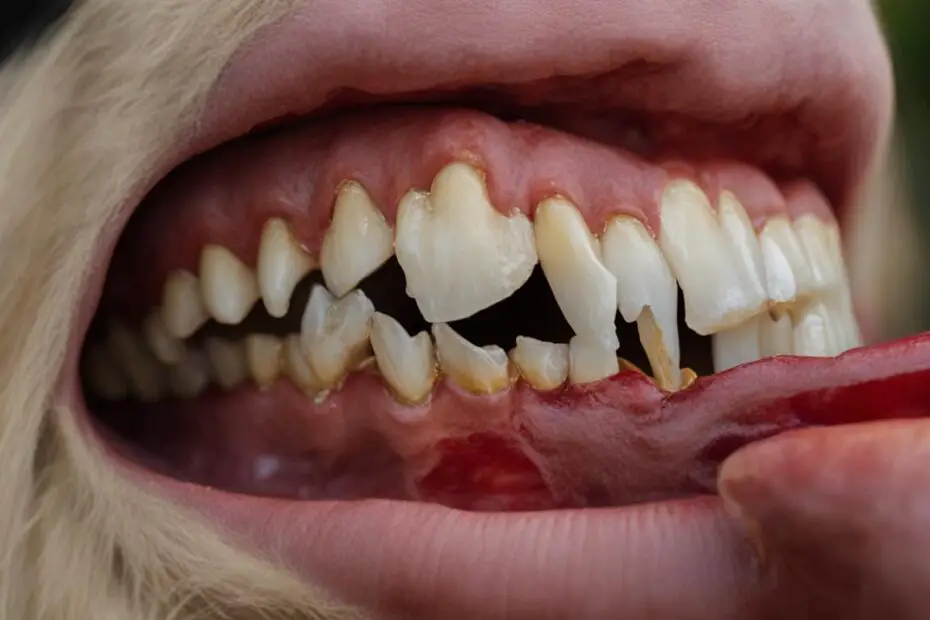A broken tooth in dogs can cause pain and discomfort, and as a pet owner, it’s essential to understand how to care for your furry friend’s dental health. Dogs can experience various types of tooth fractures, including enamel fractures, crown fractures, and root fractures. While some dogs may not show any signs of discomfort, others may exhibit symptoms such as chewing on one side of their mouth, excessive salivation and drooling, pawing at the face, teeth grinding, swollen face, and reluctance to chew on hard objects.
If you suspect that your dog has a broken tooth, it’s crucial to seek veterinary care. Treatment options for broken teeth in dogs include endodontic therapy, such as a root canal or pulp therapy, to save the tooth. However, if the tooth is severely damaged, extraction may be necessary to prevent further complications and alleviate pain.
To prevent broken teeth in dogs, regular dental care is vital. This includes brushing your dog’s teeth and providing appropriate chew toys. By taking the necessary steps, you can ensure your dog’s dental health and overall well-being.
Key Takeaways:
- Symptoms of a broken tooth in dogs include chewing on one side of the mouth, excessive drooling, and pawing at the face.
- Treatment options for broken teeth in dogs may include endodontic therapy or tooth extraction, depending on the severity of the fracture.
- Untreated broken teeth in dogs can lead to chronic pain, infection, and other health complications.
- Preventive measures such as regular dental care and providing appropriate chew toys can help reduce the risk of broken teeth in dogs.
- Consult with a veterinarian for proper diagnosis and treatment of broken teeth in dogs.
Recognizing Broken Teeth in Dogs
Broken teeth in dogs can sometimes go unnoticed, as many dogs do not show obvious signs of oral pain. However, there are several symptoms that pet owners can look out for to determine if their dog may have a broken tooth. These symptoms include:
- Avoiding eating or chewing
- Chewing on one side
- Messy eating or food falling from the mouth
- Excessive drooling
- Pawing or rubbing the mouth
- Facial swelling
- Enlarged lymph nodes
- Lethargy
- Behavioral changes
- Reactions to petting around the face or head
- Refusing to play with chews or toys
If any of these symptoms are observed, it’s important to be vigilant and seek veterinary care for your dog. Prompt diagnosis and treatment for broken teeth can help alleviate pain and prevent further complications.
“As a pet owner, it’s crucial to pay attention to any changes in your dog’s behavior or eating habits, as these could be indicators of dental problems,” says Dr. Emily Thompson, a veterinarian at Barkwell Veterinary Clinic. “Regular dental check-ups with your vet can help catch broken teeth early on and ensure your dog’s dental health.”
To help raise awareness about dental problems in dogs, here is a visual guide to common signs of broken teeth:
| Signs of Broken Teeth in Dogs | Description |
|---|---|
 |
Bleeding gums, swelling, and discomfort |
 |
Avoiding hard or crunchy foods |
 |
Inability or reluctance to chew on toys or bones |
Remember, if you observe any of these signs or suspect that your dog may have a broken tooth, it’s important to consult with your veterinarian for an examination and appropriate treatment. Ignoring dental problems in dogs can lead to pain, infection, and other complications.
Treatment Options for Broken Teeth in Dogs
When a broken tooth is diagnosed in a dog, there are several treatment options available. The specific treatment chosen depends on factors such as the location and severity of the fracture, the dog’s overall health, and the extent of the damage to the tooth. Two common treatment options for broken teeth in dogs are endodontic therapy and tooth extraction.
Endodontic therapy, such as root canal or pulp therapy, can sometimes save the tooth if it is in good condition and not severely damaged. This procedure involves removing the damaged tissue from within the tooth and filling it with a dental material to restore its strength and functionality. It is an effective way to treat fractured teeth in dogs and avoid extraction when possible.
On the other hand, if the tooth is in bad shape or significantly damaged, extraction may be necessary. Dog tooth extraction involves the removal of the broken tooth under anesthesia to prevent further pain and complications. Although losing a tooth can be concerning, dogs can adapt well to the loss and still have a good quality of life.
It’s important to consult with a veterinarian to determine the best course of action for your dog’s broken tooth. They will carefully evaluate the tooth and consider all relevant factors to recommend the most appropriate treatment option.
Here is a breakdown of the treatment options:
| Treatment Option | Description |
|---|---|
| Endodontic Therapy | A procedure to save and restore the damaged tooth through root canal or pulp therapy. |
| Tooth Extraction | The removal of the broken tooth under anesthesia to prevent further complications. |

Risks of Untreated Broken Teeth in Dogs
Leaving a broken tooth in a dog untreated can have severe consequences on their canine dental health. One of the most common risks of an untreated broken tooth is chronic pain for the dog. The fractured tooth can expose sensitive nerves, causing constant discomfort. Not addressing the issue promptly can significantly impact the dog’s quality of life and overall well-being.
Furthermore, there is an increased risk of infection and abscess formation when a broken dog tooth is left untreated. Bacteria can enter through the openings in the fractured tooth, leading to infection within the oral cavity. Over time, the infection can spread to other parts of the body, resulting in more serious health problems for the dog.
Addressing broken teeth in dogs promptly is essential to prevent these risks and ensure optimal canine dental health. By seeking veterinary care and appropriate treatment, pet owners can help alleviate the dog’s pain, prevent infection, and promote overall oral well-being.
Preventing Broken Teeth in Dogs
Taking preventive measures can help reduce the risk of broken teeth in dogs. By providing appropriate chew toys and bones that are suitable for the dog’s age and size, pet owners can help prevent tooth fractures. It’s important to choose toys and bones that are softer than the dog’s teeth to avoid damage and breakage. Antlers and compressed nylon toys, which are harder than a dog’s teeth, should be avoided.
Chewing on hard objects over time can lead to microfractures in the teeth, increasing the chances of future fractures. Therefore, it’s essential to select chew toys that are not only safe for the dog but also promote dental health.
“Choosing the right chew toy not only provides entertainment for your furry friend but also plays a crucial role in maintaining their dental well-being,” says Dr. Emily Adams, a veterinarian at Healthy Paws Animal Hospital.
Regular dental care is also vital in preventing broken teeth in dogs. Just like humans, dogs need their teeth brushed regularly to maintain their dental health.
“Brushing your dog’s teeth is an essential part of their dental care routine,” Dr. Adams advises. “Using a dog-safe toothbrush and toothpaste, you can help remove plaque and tartar buildup, which can contribute to tooth decay and fractures.”
In addition to regular brushing, a variety of dental hygiene products, such as dental chews and water additives, can be incorporated into a dog’s routine to promote oral health and reduce the risk of broken teeth.
Choosing the Right Chew Toy
When it comes to selecting chew toys for dogs, not all toys are created equal. It’s important to choose toys that are specifically designed to promote dental health and prevent tooth fractures.
A good chew toy should have some give when bitten into, rather than being rock-hard. Look for toys made from materials like rubber or soft plastics that can withstand chewing without breaking or splintering.
| Safe Chew Toys | Avoid These Chew Toys |
|---|---|
| Dental ropes | Hard antlers |
| Rubber toys | Compressed nylon toys |
| Kong toys | Real bones |
Remember, supervision is essential when allowing dogs to chew on toys, as even the safest options can pose a risk if fragments are ingested. If you notice any signs of wear or damage on a chew toy, it should be replaced immediately to ensure your dog’s safety.
By taking steps to prevent broken teeth in dogs, pet owners can ensure their furry friends’ dental health and overall well-being. Providing appropriate chew toys, regular dental care, and being mindful of the materials used in toys can go a long way in keeping dogs’ teeth healthy and strong.
Conclusion
Broken teeth in dogs can be a painful and serious issue that requires prompt veterinary care. As responsible pet owners, it’s crucial to be aware of the signs and symptoms of a broken tooth in dogs and seek treatment if necessary to ensure their dental health and overall well-being.
With the right treatment options, such as endodontic therapy or tooth extraction, broken teeth in dogs can be effectively addressed. However, prevention is always better than cure. Regular dental care, including brushing your dog’s teeth and providing appropriate chew toys, is essential in maintaining their dental health and preventing tooth fractures.
By being proactive and attentive to your dog’s oral health, you can help maintain their healthy smile and minimize the risk of broken teeth. Remember, a healthy mouth contributes to your canine companion’s overall well-being. So, make dental care a priority and ensure your beloved pet enjoys a pain-free and happy life.
FAQ
What are the symptoms of a broken tooth in dogs?
The symptoms of a broken tooth in dogs can vary, but some common signs include chewing on one side of their mouth, excessive salivation and drooling, pawing at the face, teeth grinding, swollen face, and reluctance to chew on hard objects.
How are broken teeth in dogs treated?
Treatment options for broken teeth in dogs depend on the location and severity of the fracture. Endodontic therapy, such as a root canal or pulp therapy, can save the tooth if it is in good condition. However, if the tooth is significantly damaged, extraction may be necessary.
What are the risks of leaving a broken tooth in a dog untreated?
Leaving a broken tooth in a dog untreated can lead to chronic pain, increased risk of infection and abscess formation, and potential health problems if the infection spreads to other parts of the body.
How can I prevent broken teeth in my dog?
Providing appropriate chew toys and bones that are suitable for your dog’s age and size can help prevent tooth fractures. Avoid giving them objects that are harder than their teeth. Regular dental care, including brushing their teeth, is also important for maintaining their dental health and preventing tooth problems.
